| |
LX521 - Reference Loudspeaker
Sound as close to Live - as the Recording
provides!
For many years now I have refined, lived with and enjoyed the
ORION (2002) and PLUTO (2005) loudspeakers. I have learned that the
loudspeaker's radiation pattern and placement in the room are more important
than the acoustics of the room
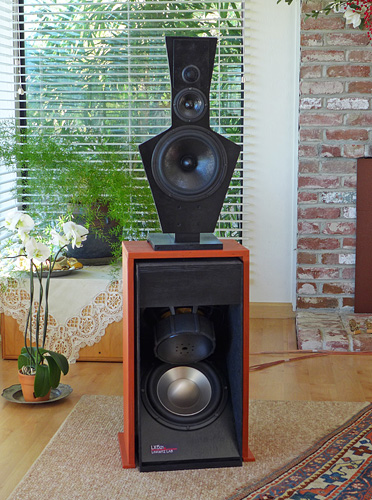 |
Ever since I started
building loudspeakers with cone-type drivers on open baffles several
decades ago, I tried to find the optimum shape for those baffles given
the drivers available. For ORION the drivers were selected primarily for
their volume displacement and low distortion capabilities when used in a
3-way, active system. The LX521 evolved from experimentation with
minimal width baffles, which can provide a more uniform dipolar
radiation pattern at higher frequencies, if also suitable drivers are
available. Inevitably this leads to a 4-way design, which I mostly tried
to avoid in the past.
The shape of the midrange/tweeter baffle was
arrived at empirically for the chosen SEAS drivers and after many
acoustic free-field measurements. The two SEAS woofer drivers are housed
in a V-frame baffle, which exhibits reduced resonance above the
operating range of the woofer and some force cancellation.
A bridge over the woofer isolates the
midrange/tweeter baffle from woofer cabinet vibrations. Woofer and
midrange/tweeter baffles can be angled independently from each other.
The bridge could also be built taller and the midrange/tweeter baffle
tilted downwards to aim at the listener in front of a mixing desk. The
woofer baffle must rest on the floor for ground plane reinforcement of
its output.
The LX521 Analog Signal Processor splits the
broadband line level input signal into woofer, mid and tweeter frequency
bands. It equalizes driver and baffle response for each channel and
filters it with LR4 response. The midrange signal is split after the
power amplifier by a passive crossover filter into lower mid and upper
mid driver inputs.
Frequency response on upper midrange axis and
horizontal dipolar response in the frontal hemisphere are designed for
neutral timbre of the the stereo phantom scene, when the loudspeakers
are placed in the room as suggested. The aural scene is rendered with
clarity and detail, both spatially and tonally.
|
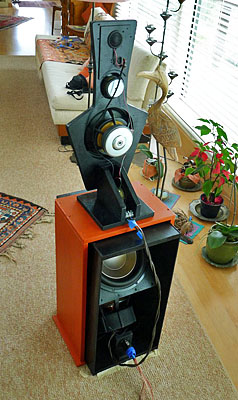
Rear-view of prototype |
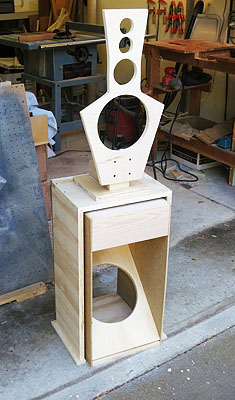
Baffle prototype |
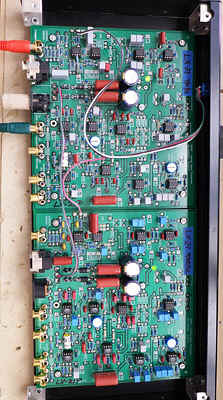
ASP prototype |
The specifics of the phantom acoustic scene that is
rendered by a pair of loudspeakers and perceived by a listener's brain depend
upon the radiation characteristics of the loudspeakers, their location in the
room, the reflective, diffusive and absorptive properties of the room and the
listener's location. The first requirement is for lateral symmetry of the
loudspeaker and listener setup with respect to large reflecting surfaces.
Secondly, the loudspeakers must be placed at some minimum distance from those
large surfaces in order to delay specular reflections by more than 6 ms. This
allows the brain to give primary attention to the earlier arriving direct sound
from the loudspeakers, if the reflected sound streams have similar timbre and
spectral content as the direct sound. This in turn requires loudspeakers with
constant, frequency independent radiation characteristics in order to illuminate
the room spectrally neutral. The LX521 represents such loudspeaker to a high
degree. The typical box loudspeaker is omni-directional at low frequencies and
becomes increasingly directional as its baffle and driver dimensions become
larger than 1/4th of the radiated wavelength. The power response typically
changes by more than 10 dB between low and high frequencies. The power response
of the LX521 is 4.8 dB lower at low frequencies and nearly constant up to 7 kHz
before it decreases.
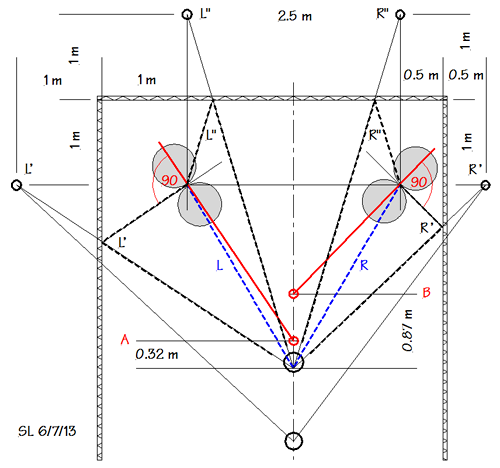 |
Top and bottom baffle
of the LX521 can be rotated independently of each other. The orientation
of the bottom baffle determines the degree to which the woofer couples
to different room modes. This provides some flexibility in dealing with
a problematic room mode by turning the woofer a certain amount. Of much
greater significance is the ability to minimize the first side wall
reflections L' and R' by orienting the top baffles. The optimum amount
of toe-in is a function of loudspeaker distance from the side walls and
distance to the listener. In the drawing on the left the right dipole is
positioned at 0.5 m from the wall and the left dipole at 1 m. In both
cases the plane of zero sound output is pointing at the first reflection
points L' and R'. The toe-in axis is at right angle to this plane and
points to A or B in front of the listener.
More toe-in is required for the right dipole that
is closer to the side wall. Toe-in has to be increased slightly for
either dipole if the listener sits farther back.
The right dipole is too close to the wall to meet
the 6 ms delay between reflected signal R' and the direct signal R, but
attenuating R' by proper toe-in greatly improves the precision of
imaging in a narrow room.
Toe-in also reduces the magnitude of the first
reflections L" and R" from the wall behind the dipoles. The
level of reverberant sound in the room and the ratio of direct to
reverberant sound at the listener are insignificantly affected by
toe-in.
You can make a drawing for your room dimensions by using your
setup distances and corresponding image sources L', L" and R', R''
to determine the optimum toe-in point.
A listener would see the top baffle from the side, if mirrors were
placed on the wall at L' and R'. |
Richard Taylor has analyzed the required room dimensions and speaker setups to
obtain a >6 ms delay for the first order reflections. He also determines the
toe-in angle for equal strength of side wall and front wall reflections in a
small room with a dipole source . I consider it more important to minimize the
side wall reflection and to diffuse, not to absorb, the front wall reflection
for optimal imaging.
James Heddle contributed a
spreadsheet,
which calculates the strength and delay of first order room reflections. Enter
your speaker's distances from the walls and adjust the
toe-in angle to minimize the reflected energy from the closest side wall. Suppression
of this reflection widens the sweet spot and this top baffle orientation places
the aural scene between the loudspeakers even for far off-center listeners.
Compare the calculated dipole reflections to those of a monopole.
A room that is not open or
acoustically dead behind the listener is likely to cause problems due to
rear wall reflections. If the distance dr between listener and wall
is l/4, i.e. when the
reflected wave has traveled l/2 relative to the incident wave, then incident and reflected waves
will cancel. The frequency response at the listener's location therefore has a
notch at frequency f = 340/4*dr . Ideally this notch is at a low
10 Hz, which means that dr = 8.5 m (28 feet), a very long room. A
more common listener-to-rear wall distance of 1.5 m (5 feet) would put the notch
around 57 Hz, right into the bass range and be very problematic. Thus every
attempt should be made to attenuate the rear wall reflection. Use a variable low
frequency sinewave signal source to hear the notch frequency range at your
listening place. Pink noise is not a good test signal for this.
The ideal listening room acts like a waveguide with
the loudspeakers at some distance from the diffuse (live) end of the room and
sound traveling past the listener to the open (dead, absorptive) end of the room
(see the drawing below). Sound reflections from the wall behind the listener
should be attenuated as much as possible, particularly below 200 Hz., the
frequency range where discrete room resonances tend to dominate the bass
distribution in the room. The LX521 being a dipole has the advantage of
minimally exciting lateral room modes due to the null in its radiation pattern.
A sound processing room is usually designed to be quiet
and acoustically dead. It is a work environment and not at all representative of
the typical living space where people listen to a stereo recording for enjoyment
but also pursue other activities. The processing room has to be dead to ensure a
direct to reverberant sound ratio of no less than -6 dB at the work place and to
minimize the influence of reflections and reverberation due to the colored
illumination of the room by the typical box-type monitor loudspeakers.
Close-field monitors at short listening distance relax the reverberation time
requirements. They approach headphone listening. Headphones are completely
unsuited for judging the spatial rendering of a stereo recording that is
intended for loudspeaker playback. Headphones are optimally suited for analyzing
tonal artifacts in a recording but completely distort distance perception.
Recording engineers often claim that they "can hear through the flaws of
their monitors" to the real sound. Then why are there so many technically
poor recordings? They would be well advised to listen to their work/mix via
LX521 Reference Loudspeakers.
An acoustically small dipole radiator in a room with T60 =
750 ms will have the same D/R ratio as an omni-directional radiator in a room
with T60 = 250 ms. One room is dead, the other very live, but at the same
distance from loudspeakers the room contributions to the sound at the listener's
ears are equally subdued compared to the direct sound coming from the
loudspeakers. The dipole loudspeaker reaches by a factor 1.73 = sqrt(3) deeper
into the room. The two graphs below and the Listening_distance.xls
spreadsheet show what this means in actual numbers. Note in particular how
steeply the required amount of wall absorption must increase to obtain a 250 ms
reverberation time. My preference is for a reverberation time of around 450 ms,
which also provides a pleasant environment for talking and reading in addition
to critical listening. The wall behind the loudspeakers should be diffusive in
order not to lose the rear radiated sound from the LX521. Specular reflection
from the side walls must not be attenuated as this reduces high frequency energy
in the room. The wall behind the listener should be lossy to attenuate room
modes. In addition, cloth wall hangings, rugs, pictures, upholstered chairs,
open cabinets, plants and other decorative elements are all that is needed to
interface a dipole loudspeaker with the room regardless of whether it is
intended for work or pleasure.

Example of a 100 m3 volume room for
which EBU specifies a 250 ms reverberation time
|

Listening distance for -6 dB D/R in the 100 m3
volume room for different reverberation times. Required open window area
in % of total room surface area.
|
See also: Sound
Field Control for Rendering Stereo
|
LX521 Characteristics &
Specifications
- Outside dimensions: 49.25"H x 16"W at
bottom x 15"D,
3 parts: Woofer baffle, Midrange/Tweeter baffle and Bridge
- Bridge can be built with increased height to raise
Midrange/Tweeter baffle, if needed
- Weight 67 lb est. (30 kg)
- Open-baffle, dipolar radiator, < 20 Hz to 20 kHz,
Acoustically small in the horizontal plane through the upper midrange
- Response -3 dB at 30 Hz (Q < 0.5) on ground plane,
free-field
- Dipolar response over +/-600 horizontal,
< 120 Hz to 10 kHz
(see Sound Field Control
for Rendering Stereo - 2)
- 4-way loudspeaker system with woofer, lower midrange,
upper midrange and tweeter
- 3-way ASP crossover/equalizer with LR4 filters at 120
Hz and 7 kHz,
assembled on two ORION ASP printed circuit boards
- Passive 1st order crossover between lower midrange and
upper midrange at 1 kHz,
located in base of midrange/tweeter baffle
- Tweeters - SEAS 27TFFNC/G, H1396-04, coated textile
dome,
front and rear of midrange/tweeter baffle
- Upper Midrange - SEAS MU10RB-SL, H1658-04, Curv cone
42" above floor
- Lower Midrange - SEAS U22REX/P-SL, H1659-08, Curv cone
- Woofer - SEAS L26RO4Y, D1004-04, Aluminum cone
Push-pull mounted in V-frame baffle of 24"H x 13"W x 15"D
- Minimum amplifier power: 8 x 60 W (e.g. ATI model AT6012)
60 W for each woofer, lower & upper midrange crossover, two tweeters in
series
- Room size: >240 ft2 (>22 m2)
area, >8 ft ceiling
- Speaker placement measured from tweeter:
>4 ft from wall behind it, >2 ft from side walls,
speaker separation >8 ft
- Listening distance 8 ft to 18 ft depending upon
loudspeaker application
- Room acoustics: Fairly live with RT60 of 400
ms to 600 ms for a natural living space
- LX521 as Mixing Monitor: - No need for RT60 = 250 ms to obtain a
sufficient Direct/Reverberant sound ratio in the room.
- More articulated bass reproduction due to reduced coupling to
room modes.
- Neutral timbre and fast time response
- Low non-linear distortion and high instantaneous dynamic range
- Optimal spatial rendering of the stereo phantom scene to judge the mix.
|

Burning Amp Festival 2012 |
From F3 to LX521
| In 2009 I had started a
project to look for a baffle shape that might provide a more ideal dipolar
response knowing that a rear tweeter was a necessity. I called the project
F3 for "Form Follows Function". It was a low priority search
because I was not convinced that improving the ORION's off-axis response
in the low kHz range would yield an audible benefit. I am still not
convinced, but it seemed like a worthy endeavor. I also wanted the F3 to
be a 3-way speaker. So I tried a variety of flat baffle shapes, different
midranges, different dome tweeters and in different front-to-back
configurations. Nothing looked really promising in my outdoor
measurements. The off-axis response in the midrange to tweeter transition
range and the compound tweeter response just did not come together.
So I gave in and started to experiment with a 4-way
driver arrangement and immediately saw promising results. |
|

|
|
I changed the project name to LX21 as this experiment
might now become my 21st completed loudspeaker design. After several iterations
I found on 5/21/12 a baffle shape that worked well with SEAS CA22RNX and FU10RB
drivers. They were combined with 1st order quasi-Butterworth filters, which are
6 dB down at the crossover frequency. Both drivers then add in-phase over a
limited frequency range. Some frequency response irregularities still had
to be cleaned up, particularly around 2 kHz.. During my F3 experiments I had
investigated the SEAS U18RNX/P. I liked its smooth response due to a new
Curv cone. SEAS provided me with a 8" Curv cone prototype using a short
voice coil. I want low voice coil inductance to have low Le(x) and Le(i)
non-linear distortion in the midrange. SEAS furthermore changed the FU10's
surround damping to optimize the driver's upper midrange response for my
application. With two well behaved and capable midrange drivers of different
size, but covering nearly the same frequency range, it became feasible to build
a very wide bandwidth, 120 Hz to 7 kHz, dipole midrange bandpass filter and keep
group delay variation low in its passband by using a 1st order crossover filter
around 1 kHz. Group delay variation relates to envelope distortion, which
in a 4-way design can be kept lower in the critical midrange than for a 3-way.
|
Crossover to the tweeter was first planned for 5 kHz. The
crossover has to be steep, because the separation between upper midrange and
tweeter tends to be acoustically large, which causes irregularities and
narrowing of the vertical polar response. The LR4 crossover affects the
frequency response for +/-1 octave around the crossover frequency. Below 5 kHz
the dispersion from a 1" dome tweeter is wide and influences the dipole
response of the summed drivers negatively. The LR4 crossover was therefore moved
to 7 kHz. This also helps to hide front and rear tweeters from each other so
that they only interfere in desired dipole fashion at large off-axis angles.
This is also the reason for widening the baffle shape around the tweeters.
Above a few kHz baffle design and driver selection become
very critical, if one tries to obtain a specific radiation pattern. Consider
that a baffle thickness of 3/4" corresponds to 1/4th wavelength at 4.5 kHz
or 900 of phase shift between front and rear edge diffraction.
Practical baffle and driver dimensions cannot be kept acoustically small at
higher audio frequencies and baffle design turns into educated cut and try with
lots of polar response measurements. The problem is that drivers are not
acoustic point sources, i.e. they are more than 1/16th wavelength in
size. This means that for a wide vertical polar response the drivers must
be placed as close together along a vertical line as physically practical. For a
controlled horizontal polar response the baffle must be narrow and have an
outline that optimizes the dipolar off-axis amplitude fall-off with angle for lower
midrange, upper midrange and tweeter drivers when measured on their own. Finally
the driver outputs are summed with appropriate crossover filters and the overall
response is equalized on-axis.
|
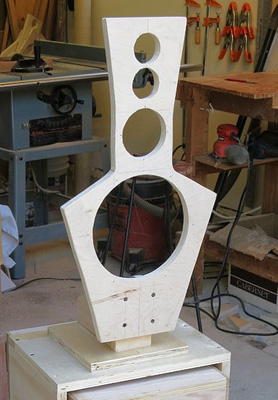 |
|
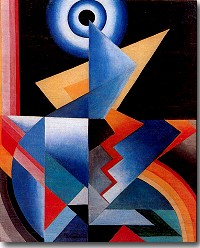 |
The shape of the
midrange/tweeter baffle is the result of acoustic requirements, as is
the woofer baffle. The baffles are angular and not hidden behind grill cloth.
The acoustic impedance of grill cloth rarely matches the acoustic field
impedance near the radiator, causing frequency dependent reflection and
transmission loss, which can also be angle dependent. The LX521 is meant
to be used without grill cloth with the exception of a light fabric
table runner over the woofer baffle to partially cover its front and
rear openings.
The loudspeaker's unusual form has evoked a variety of
reactions:
- Interesting, I like it.
- LX521 recalls the esthetics of Italian
futurismo.
- The top looks like a vase.
- Like a lamp on a stand without a lamp shade.
- Aggressive looking, Heavy Metal. I like it.
- My wife is not keen on the shape. Attached is a slightly different
design that my wife could live with.
- It's ugly. How can I hide it?
Paint
can make a big difference in how dominant a form appears in your room. I
like the black silhouette, the red bridge and the angularity of shapes,
as does my wife. I envisioned the LX521 as a piece of machinery, an
electro-acoustic transducer, a sculpture with acoustic integrity. I cannot help you if the looks prevent you from
building them. Sorry.
|
|
The two SEAS 10" woofers ended up in a V-frame baffle
after I had first tried a W-frame for force cancellation. I did not like the
complexity of baffle construction, given my DIY skills for square joints. I
also wanted the baffles to use as few wood parts as possible, to eventually
provide a low cost flat-pack of parts. The V-baffle also has a less pronounced
resonance above the working range of the woofer than a W-frame. Even with the
W-frame much mechanical vibration was coupled to the midrange/tweeter baffle
when it was placed directly upon the woofer baffle. Therefore a bridge is placed
over the V-frame woofer, which detaches the woofer from the midrange/tweeter
baffle.
The frequency response on the upper midrange axis was
designed to be flat. The free-field woofer/midrange response was shelved down by
4.2 dB to account for floor reinforcement. When listened to on program material
in my room it became apparent that the high end had to be shelved down slightly.
I use the same -3.3 dB shelf as for ORION.
It merely requires a resistor and a capacitor on the circuit board. The resistor
is easily removed to hear a flat response. A flat response is needed when the
loudspeakers are used for wave-field reconstruction purposes. For phantom acoustic
scene creation, as in 2-channel stereo, a slightly rolled off high frequency
response is indicated by the sphere derived HRTF for loudspeakers at +/-300.
The overall result is a speaker that provides a neutral
sound, clarity, speed and spatial openness. Whether this is due to the improved
polar response, due to inherent qualities of the midrange drivers, or the 1st
order crossover, or all of
these, I do not know. For its sonic qualities, wide range of applications and an
important date in its development, I call it the LX521 Reference Loudspeaker.
After listening to a great variety of good, bad and so-so
stereo recordings I am tempted to call it MAGIC521. The music comes through!
|
|